The Brazos Performance Preview: AMD E-350 Benchmarked
by Anand Lal Shimpi on November 16, 2010 12:01 AM ESTMemory and Cache Latencies
The Brazos platform was configured with 4GB of DDR3-1066 memory. The IDF system had memory running at DDR3-1333, however AMD had to decrease clocks presumably to meet validation requirements for final silicon. I measured an 86.9ns trip to main memory, a 3 cycle L1 and a ~22 cycle L2 cache. That's a lower latency memory interface than Atom or Core 2 based processors, but a higher latency L2.
CPU Performance: Better than Atom, 90% of K8 but Slower than Pentium DC
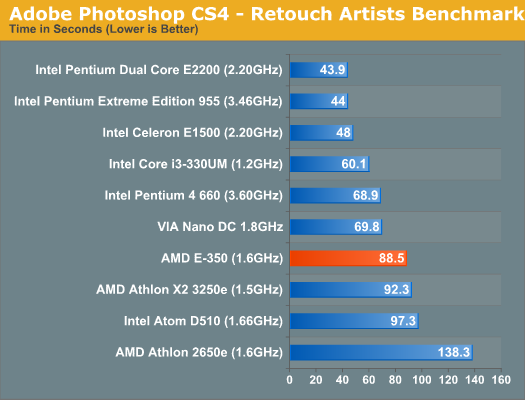
AMD's performance target for Bobcat was 90% of the performance of K8 at the same clock speed and our Photoshop CS4 benchmark shows that AMD can definitely say that it has met that goal. At 1.6GHz the E-350 manages to outperform a pair of K8s running at 1.5GHz in the Athlon X2 3250e. Unfortunately for AMD, Intel's Pentium dual-core running at 2.2GHz is much quicker. Most notebooks in the $400+ range have at least a 2.2GHz Pentium. Even the Atom D510 isn't far behind.
AMD tells me that in general purpose integer tasks, the E-350 should do well and it may even exceed AMD's 90% design target. However in higher IPC workloads, for example many floating point workloads, the E-350 is constrained by its dual issue front end. In these situations, the out of order engine is starved for instructions and much of Bobcat's advantage goes away.

Our x264 HD test has the E-350 performing within 86 - 92% of the Athlon X2 3250e, once again meeting AMD's design targets. Unfortunately, this isn't much faster than an Atom - mostly thanks to Atom's Hyper Threading support. Although not an out of order architecture, Atom gets a healthy efficiency boost by being able to execute instructions from two threads per core. Once again, compared to a 2.2GHz Pentium, the E-350 isn't close. Even VIA's dual core Nano is faster. When it comes to power consumption however, the E-350 can't be touched. I measured max system power consumption at 25.2W while running the x264 encode test. With the exception of the Atom D510, the rest of the desktop platforms here consume much more than that at idle (much less under load).
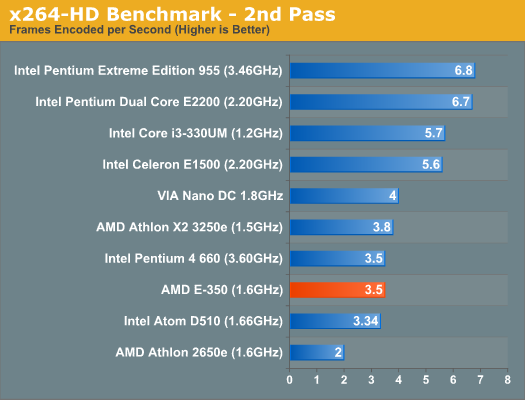
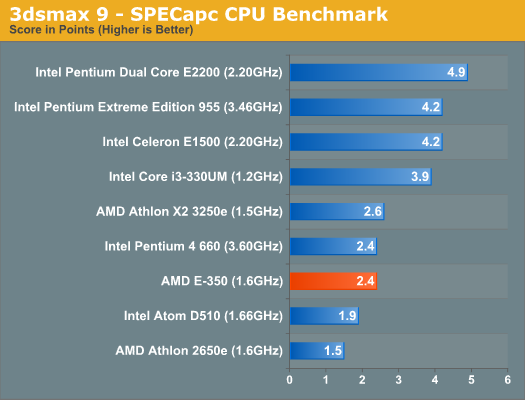
Despite being a offline 3D rendering benchmark, our 3dsmax 9 test does fall in line with expectations. The E-350 delivers 92% of the performance of the Athlon X2 3250e and outperforms the Atom D510 by 26%. Unfortunately for AMD, the Pentium dual-core holds onto a significant performance advantage here. Clock for clock, Bobcat won't be able to do much against anything Core 2 based. The real advantage here will be GPU performance.
Single Threaded Performance
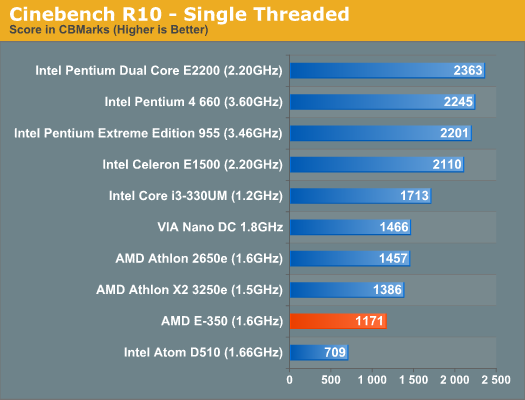
In most of our benchmarks the performance advantage over Atom isn't huge, yet using Brazos is much better than using an Atom based machine. It all boils down to one thing: single threaded performance. Atom can make up for its deficiencies by executing a lot of threads in parallel, but when you're bound by the performance of a single thread the E-350 shines. The E-350 is 65% faster than the Atom D510 in the single threaded Cinebench R10 test. It's this performance advantage that makes the E-350 feel so much quicker than Atom.
The Core i3-330UM manages a 46% performance advantage over the E-350. Even in the ultraportable Arrandale ULV space at lower clocks, AMD still leaves a lot of CPU performance on the table. The advantage here will be cost. A single E-350 is less than 40% of the die area of a Core i3-330UM. You may not get the same CPU performance, but performance per mm^2 is much higher.

In the multithreaded Cinebench test Atom is able to catch up quite a bit, but the E-350 still holds an 11% advantage.
File Compression/Archive Recovery Performance
Our final two CPU tests are both multithreaded and they show the E-350 equaling and falling behind the performance of the 1.5GHz Athlon X2. As we explained earlier, the gap between the E-350 and Atom shrinks as you add more threads to the workload.

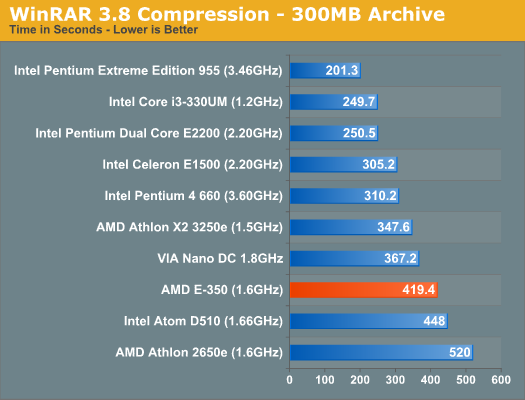










207 Comments
View All Comments
legoman666 - Tuesday, November 16, 2010 - link
are missing.Anand Lal Shimpi - Tuesday, November 16, 2010 - link
Power consumption was listed at the end of the first page. The systems used throughout the rest of the article were based on desktop hardware, so it didn't make sense to compare to those numbers (the Brazos numbers include the test platform's LCD display). We'll have to wait for final notebook hardware to do real comparisons to competing notebook platforms. But at 25 - 30W for the entire system (including display) under load, Brazos is definitely in the right league.Take care,
Anand
Sc4freak - Tuesday, November 16, 2010 - link
Still seems to be missing something from page 3:"When it comes to power consumption however, the E-350 can't be touched. I measured max system power consumption at "
And then it just cuts off.
Anand Lal Shimpi - Tuesday, November 16, 2010 - link
er, oops...fixed :)Take care,
Anand
jensend - Tuesday, November 16, 2010 - link
Hm. From the third page:"the rest of the desktop platforms here consume much more than that at idle (much less under load)."
Unless the desktop platforms really suck much more than 25W idling and much less than 25 under load, this isn't exactly fixed.
I find it odd that you're even troubling to compare this to systems which suck tons more juice and not even throwing up a power consumption chart. I mean, we could certainly find that Brazos performance is rather limited compared to a Gulftown with 3xSLI GF 580s, but that's not going to tell us a lot about what makes a better laptop. If you did a performance vs. power draw scatter chart or something that'd be a lot more interesting.
Sure, it's a little bit apples-to-oranges since you've chosen to compare it to desktop systems. But maybe that should make you reconsider what you're comparing it to (don't you have a good number of laptops around?) rather than leaving power consumption data out of the picture.
quiksilvr - Tuesday, November 16, 2010 - link
Soprano'dsinigami - Wednesday, November 17, 2010 - link
uh, since there were so many missing parts to the article, maybe you are missing some charts on page 4 or something? because i only see three, and against the Clarkdale, the zacate wins only the first one, ties on the second one, and loses on the third. With only one win, that page's headline should NOT say it's faster than Clarkdale!you could say that the Clarkdale IGP wins or ties the zacate on two out of three gaming benchmarks, and declare it faster.
sheesh, is that some biasedness, or just wishful thinking?
wiak - Tuesday, November 16, 2010 - link
is it even suposed to be competive with E4400 anyway?, isnt the whole point of it to be power efficient, faster, use less power and totally own atom in graphics/video department?Danube is amd's mainstream competition to E4400, Core 2, Core i3, i5 etc
Brazos is amd's low power competition to atom
wiak - Tuesday, November 16, 2010 - link
correction: E2200 but E4400 aint that far away :PDark_Archonis - Tuesday, November 16, 2010 - link
... Except it does not use less power than an Atom platform. It uses more power than an Atom platform. Also as the benchmarks show, performance-wise it's barely faster than an Atom D510 in some situations.